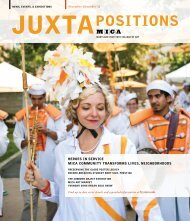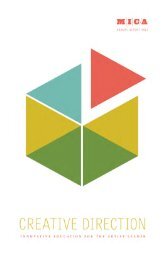art/vision/voice - Maryland Institute College of Art
art/vision/voice - Maryland Institute College of Art
art/vision/voice - Maryland Institute College of Art
You also want an ePaper? Increase the reach of your titles
YUMPU automatically turns print PDFs into web optimized ePapers that Google loves.
44 <strong>art</strong> / <strong>vision</strong> / <strong>voice</strong><br />
became a lot more focused, like, “This is the script, this is what<br />
we’re going to do. Everything we work toward from this moment<br />
on is going to be stuff for the show.” So they really did have to pull<br />
the reins in and get a bit more focused. They still had to learn lines,<br />
and block the space, and rehearse it. And the intensity and the energy<br />
rose up, too. The kids really rose to the challenge <strong>of</strong> being able to<br />
hammer all these bits <strong>of</strong> writing and movement into a show that<br />
they could put up in three weeks.<br />
It was fascinating then, because we got to see how the stuff we’d<br />
done before could actually go into the show. We were actually able<br />
to filter through all that stuff—the bits <strong>of</strong> dialogue, the movements<br />
that grew out <strong>of</strong> the exercises—and figure out how to use it.<br />
elsa It was cool, because I don’t have to say I performed this play written<br />
by this person. I can say I performed this play which I wrote, in which<br />
me and other people had a lot <strong>of</strong> input, we all had input in the<br />
script. It’s really different to write something and then act it out. It’s<br />
really good. It’s great to know that you’re acting something that you<br />
go through, that’s going on.<br />
We’d do writing exercises to create the material for the show. It<br />
was a lot <strong>of</strong> fun, and a lot <strong>of</strong> people who saw the show said that it is<br />
what normally kids, teenagers our age, go through every day. That<br />
was really eye opening, the fact that we didn’t try to put that out<br />
there for their eyes, but they saw it in the production anyway.<br />
The movement worked the same way, it grew out <strong>of</strong> the exercises.<br />
We’d do impulse exchange. That’s where a lot <strong>of</strong> our writing came from<br />
that ended up in the script. There were a lot <strong>of</strong> people from<br />
Columbia who helped me out a lot, who were always there like, “This<br />
is good, but try doing this. See if you like it.” And sometimes I’d get<br />
aggravated because I was like, “This is how I want to do it.” And<br />
they’d be like, “Just try it and if you like it, then you know, and if<br />
not, then go back to the one you had.” And I always ended up liking<br />
it the way they wanted me to do it!<br />
I know that if it wasn’t for all the people who were there helping<br />
Luis, the production wouldn’t have been how it came out. A lot<br />
<strong>of</strong> my friends mentioned that they would like to see a second p<strong>art</strong> <strong>of</strong><br />
Merging Into You. I’m more than willing to do a second p<strong>art</strong> <strong>of</strong> it,<br />
because that play gave me so much energy. It’s amazing.<br />
kym I wanted to do more teaching, and I had the opportunity to work<br />
with Free Street over the summer. And some <strong>of</strong> the Association<br />
House kids were doing stuff at Free Street — it was amazing for<br />
them, the same kids got to work together on the stuff that we did<br />
Impulse exchange is an exercise in which<br />
the p<strong>art</strong>icipant receives impulses from an<br />
outside source (someone swings his/her<br />
arm, taps his/her shoulder) and explores<br />
physically from that “impulse point” by<br />
curving the body from the impulse point<br />
into itself, discovering and experimenting<br />
with different movement possibilities. If<br />
the p<strong>art</strong>icipant focuses completely on the<br />
points from which he or she is curving,<br />
the mind should open and in turn be<br />
more receptive and concentrated.
















